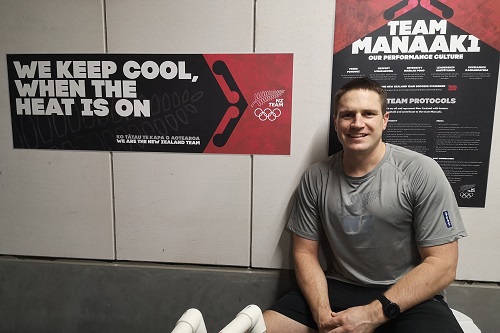Source: University of Waikato
When Stephen Fenemor was a boy, growing up in Motueka at the top of the South Island, he dreamed of representing his country.
The sports-mad kid from Motueka High School enjoyed playing rugby and cricket, and channelled that passion into studying sports science at university.
Last October, while finishing up his Doctor of Philosophy (PhD) in Health, Sport and Human Performance from the University of Waikato, Stephen landed his dream job as a performance physiologist at High Performance Sport New Zealand (HPSNZ).
“My role is to work across lots of different campaigns and be a liaison or contact for heat research,” says Stephen, who is the Heat Lead for a dozen different Olympic and Paralympic teams.
In mid-July, he flew out to Japan as part of the HPSNZ Preparation and Recovery team supporting the New Zealand athletes at the Tokyo 2020 Olympic Games, which runs from Friday 23 July to Sunday 8 August 2021.
“It’s a very exciting opportunity,” says Stephen, 30, who is enjoying being at his first Olympics.
“It’s a real privilege to be part of it; even though you are not an athlete you get to represent your country. For an athlete, it’s the pinnacle of your sport, and for a practitioner as well, it’s a time to test yourself and back your own knowledge and deal with a diverse range of sports and situations.”
Stephen’s PhD research at Waikato University focused on heat management strategies, including how athletes prepare to perform in the heat and cooling strategies for training and competing in hot conditions.
It is this expertise from HPSNZ’s Performance Physiology team that our Olympic athletes are relying on in Tokyo, which is predicted to be the hottest Olympic games on record.
“In Tokyo, it could be 35 degrees (Celsius) and up to 80 percent humidity during the Olympic period,” says Stephen. “Those conditions can feel like up to 50 degrees (Celsius).”
An increase in core body temperature can impact human performance, says Stephen.
“If your core temperature is 37 degrees Celsius, that is normal, but a movement of two degrees, to 39 degrees, and you can start to exhibit signs of hyperthermia [elevated body temperature].”
“When you get too hot you are unable to perform at the same intensity. For example, once your core temperature is elevated above 39 degrees, repeated sprint performance or ability to maintain the same intensity can decline for some athletes.”
Stephen began his PhD research in mid-2018, a collaboration between Waikato University, HPSNZ and New Zealand Rugby. Although still finalising his thesis, the research and relationships built with athletes, coaches and teams have informed his work with HPSNZ.
It involved developing heat management strategies for Rugby Sevens under the guidance of supervisors Martyn Beaven, Nicholas Gill and Matt Driller at the University of Waikato Adams Centre for High Performance in Mount Maunganui, along with supervision from Julia Casadio of HPSNZ, who is an expert in heat management strategies for elite athletes.
“I loved living in Mt Maunganui,” recalls Stephen. “Doing my PhD there was really special, especially working with an elite sports team.”
“When I started in 2018, not a lot of heat research had been done in an applied sports context, especially in team sports or contact sports, like Rugby Sevens.”
He began with his research trials in Fiji, travelling with the Men’s Rugby Sevens team, and measuring the impact of heat on individual athletes during tournament conditions.
“I’m really grateful that they made me feel part of the team and included me. They were really keen to learn as well, and were driven and focused.”
He also worked with the Women’s Rugby Sevens teams.
One of the strategies was post-exercise hot water immersion – sitting in a 40 degree Celsius hot water tub for 40 minutes after training, with fluids restricted.
“Those sessions were the hardest on the athletes. They told me that they hated me a lot,” laughs Stephen.
Due to Covid-19 restrictions, many Olympic athletes were not able to train or compete overseas as they normally would.
Instead, to prepare for the Tokyo heat, many of our Olympic teams used heat chamber facilities, such as the Adams Centre.
To mimic the hot, humid conditions, the heat chamber was set to 35 degrees Celsius and 80 percent humidity. Stephen worked with the Rugby Sevens performance team to monitor and track athletes’ vital signs including their core temperature, heart rate, sweat rate and thermal comfort.
Typically, athletes on Erg bikes can lose a large amount of sweat per hour while training or competing in the heat.
“In the chamber there at Mt Maunganui, sometimes we’d have all the [Men’s Rugby Sevens] boys in there at once, 20 athletes and probably on average they’d have a sweat rate of 1.5-2 kilograms per hour, so in a 45 minute session you’ve got about 30 litres of sweat on the ground.”
Using the heat chamber regularly helped the athletes better prepare and acclimatize to hot, humid conditions.
Researchers were able to trial cooling strategies, including the use of ice vests and ice slushies before and during training.
During the Tokyo Olympics, Stephen is working closely in a three-person Preparation and Recovery team, which also includes a nutritionist and a strength and conditioning coach.
“We are in charge of delivering those services to the New Zealand Olympic athletes at the Olympic Village to prepare and recover from their events.”
He is confident that the wrap-around support will ensure athletes are ready to perform at their best.
“The whole point of me being there is so the Tokyo heat is not an issue for the athletes. We are prepared and ready for it.”



